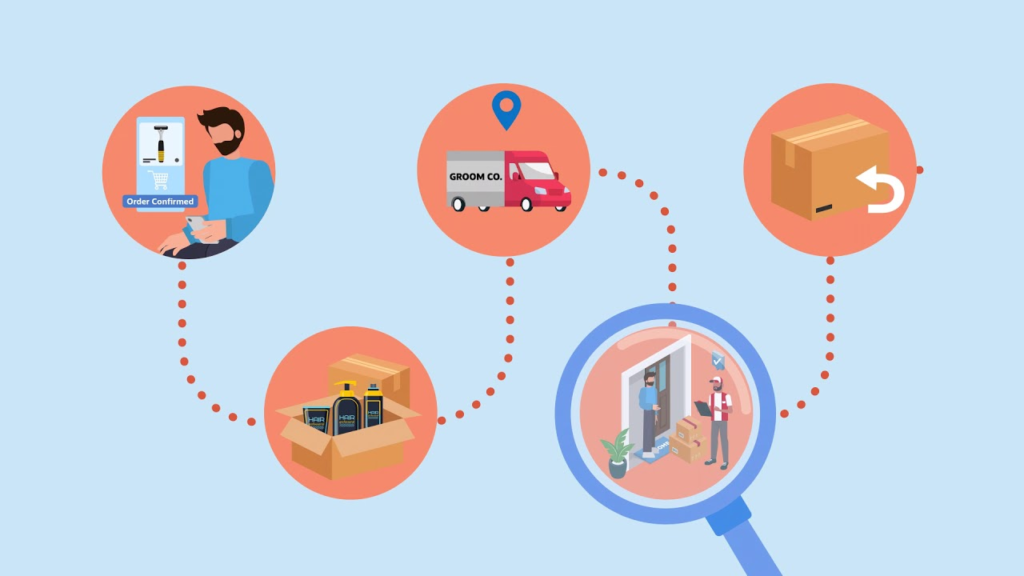Service Fulfillment Executive (1 years course)
Service Fulfillment Executive click here
Brief Job Description
This individual in the job role receives & stores goods in retail operations, processes customer orders and
delivers the products to the customers at their premises in Retail operations and e-commerce working
environment.

S/he engages with the customer for various transactions like accepting and processing payments,
customer queries, and product returns.
Personal Attributes
The individual needs to be physically fit and willing to work outdoors. The job requires the individual to demonstrate courteousness, punctuality and sense of responsibility.
To receive and store goods in retail operations
Description
This OS describes the skills and knowledge required to effectively prepare, receive, and store goods in retail operations.
Scope
The unit / task covers the following
prepare to receive goods
receive goods
store goods
Elements and Performance Criteria
Prepare to receive goods
To be competent, the user/individual on the job must be able to:
PC1. use the stock control system to identify current stock levels, the stock levels needed and any shortfalls in stock.
PC2. confirm appropriate storage space availability.
PC3. check and confirm that all equipment required for receipt and movement of goods is available and in good working order.
PC4. complete required paperwork, checking for accuracy and completeness.
PC5. ensure that the area for receiving goods is clean, tidy and free from obstruction and perils.
PC6. report any shortfall in space or malfunction with equipment to supervisor

Receive Goods
To be competent, the user/individual on the job must be able to:
PC7. check that all goods as detailed in the delivery note have been received.
PC8. record refusals accurately following organizational standard operating procedures.
PC9. accurately update stock control systems to reflect receipt of goods
Store goods
To be competent, the user/individual on the job must be able to:
PC10. confirm storage requirements and conditions for the incoming goods.
PC11. ensure appropriate handling procedures for perishable and non-perishable goods is in place.
PC12. follow all relevant legislation and organisation policies and procedures.
PC13. complete all administrative procedures to ensure appropriate rotation of goods.
Knowledge and Understanding (KU)
The individual on the job needs to know and understand:
KU1. requirements for maintaining security and safety during delivery and storage of goods.
KU2. policies for receiving and storing a range of products including perishable goods.
KU3. administrative procedures required for receiving and storing goods.
KU4. refusal procedures in relation to type of goods being delivered.
KU5. supervisors for reporting product shortages or over supply.
KU6. supervisors for reporting malfunctioning or hazardous handing equipment
KU7. the need to thoroughly prepare for receipt and storage of goods.
KU8. the scope of information required on quantity and type of goods.
KU9. the storage requirements for a range of products types including perishable goods.
KU10. the lifecycle of perishable products in storage (if applicable).
KU11. reporting requirements for shortage of storage space.
KU12. consequences of inaccurate recording and reporting of goods in receipt and storage.
KU13. what equipment is required for the delivery and movement of goods into storage.
KU14. the operations and function of the handling equipment.
KU15. fault finding procedures and reporting requirements.
KU16. work health and safety requirements in the delivery and storage areas.
KU17. security systems in place for loss prevention.
Generic Skills (GS)
User/individual on the job needs to know how to:
GS1. complete documentation accurately
GS2. write simple reports when required
GS3. read information accurately
GS4. read and interpret data sheets
GS5. follow instructions accurately
GS6. use gestures or simple words to communicate where language barriers exist
GS7. use questioning to minimize misunderstandings
GS8. display courteous and helpful behavior at all times
GS9. make appropriate decisions regarding the responsibilities of the job role
GS10. plan and schedule routines
GS11. build relationships with internal and external customers
GS12. respond to breakdowns and malfunction of equipment
GS13. respond to unsafe and hazardous working conditions
GS14. respond to security breaches
To deliver products to customers
Description
This OS describes the skills and knowledge required to deliver products to customer
Scope
This unit applies to individuals to deliver products to customers in retail operations.
Delivery of products to customers
Elements and Performance Criteria
Delivery of products to customers
To be competent, the user/individual on the job must be able to:
PC1. check that he/she has the equipment and paperwork needed for the delivery.
PC2. check that he/she has all the delivery details needed and that he/she knows how to get to the delivery address.
PC3. plan a schedule of deliveries which makes the best use of time and other resources.
PC4. check that he/she has enough fuel in the vehicle for the delivery schedule and follow company procedures for getting more fuel if needed.
PC5. transport products and equipment safely and securely.
PC6. deliver products at the times agreed with the customer.
PC7. take action in line with company procedures if you expect to arrive at the customers premises early or late.

PC8. follow company procedures for ensuring that deliveries are left only with individuals who may legally receive them.
PC9. take action in line with company procedures if no one is available who can receive the delivery or if the customer rejects the delivery.
PC10. unload orders safely and in ways which protect the orders from damage.
PC11. treat the customer courteously throughout the delivery process.
PC12. update records of delivery and nondelivered promptly and in line with company procedures.
Knowledge and Understanding (KU)
The individual on the job needs to know and understand:
KU1. how to check that he/she has all the products that are due to deliver.
KU2. how to check that he/she has enough fuel for the delivery schedule, and company procedures for getting more fuel if needed.
KU3. why it is important to deliver products at the times agreed with customers.
KU4. the company procedures to follow if he/she expects to arrive at the customers premises early or late.
KU5. relevant legal restrictions on who can receive delivery.
KU6. the company procedures to follow when no one is available who can receive the delivery and when the customer rejects the delivery.
KU7. why it is important to treat customers courteously, and how to do this.
KU8. the records to keep of deliveries and nondelivered and company procedures for completing these
KU9. how to transport products and equipment safely and securely.
KU10. the importance of planning an efficient delivery schedule and how to do this.
KU11. how to unload goods safely and in ways which protect goods from damage.
Generic Skills (GS)
User/individual on the job needs to know how to:
GS1. complete documentation accurately
GS2. write simple reports when required
GS3. read information accurately
GS4. read and interpret data sheets
GS5. follow instructions accurately
GS6. use gestures or simple words to communicate where language barriers exist
GS7. use questioning to minimise misunderstandings
GS8. display courteous and helpful behaviour at all times
GS9. make appropriate decisions regarding the responsibilities of the job role
GS10. plan and schedule routines
GS11. build relationships with internal and external customers
GS12. respond to breakdowns and malfunction of equipment
GS13. respond to unsafe and hazardous working conditions
GS14. respond to security breaches
To process customer orders for goods
Description
This OS describes the skills and knowledge required to process customer orders for goods.

Scope
This unit applies to individuals who process customer orders for goods in retail operations.
Check the availability of goods for orders
Process orders for customers
Elements and Performance Criteria
Check the availability of goods for orders
To be competent, the user/individual on the job must be able to:
PC1. identify customers’ needs accurately by asking suitable questions.
PC2. identify the goods that will meet customers’ needs and check with customers that these are satisfactory.
PC3. find out who can supply the goods needed and on what terms.
PC4. keep customers informed of progress in finding the goods they need.
PC5. give customers clear, accurate and complete information about the availability of goods and the terms of supply.
Process orders for customers
To be competent, the user/individual on the job must be able to:
PC6. follow legal and company procedures for checking the customer’s identity and credit status.
PC7. follow company policy for offering to order goods the customer needs if they are not in stock.
PC8. prepare accurate, clear and complete information about the order & pass this information to people
responsible for fulfilment.
PC9. provide accurate, clear, complete and timely information to those responsible for issuing the invoice.
PC10. tell the right person promptly when he/she cannot process an order and explain the reasons clearly.
PC11. let the customer know promptly and politely if their order cannot be delivered within the agreed time.
PC12. store customers’ details securely and show them only to people who have a right to see them.
Knowledge and Understanding (KU)
The user/individual on the job needs to know and understand:
KU1. how to ask the right questions to find out exactly what customers want.
KU2. the items in stock.
KU3. how to check whether there is enough stock to meet the order.
KU4. which items are available by order and which suppliers and manufacturers can provide them.
KU5. how to check whether external suppliers and manufacturers can provide items, and on what terms.
KU6. how to keep customers informed of progress in finding the goods they need.
KU7. how to give customers clear, accurate and complete information about the terms of supply.
KU8. legal and company procedures for checking the customer’s identify and credit status.
KU9. how to tell the customer promptly about any delays in fulfilling their order.
KU10. legal and company requirements relating to customer confidentiality.
KU11. who is entitled to see customer information, and in what situations.
KU12. how to invoice customers for orders.
KU13. how to escalate in case you cannot process an order.
KU14. company procedures for storing customer information securely.
Generic Skills (GS)
User/individual on the job needs to know how to:
GS1. complete documentation accurately.
GS2. write simple reports when required.
GS3. read information accurately.
GS4. read and interpret data sheets.
GS5. follow instructions accurately.
GS6. use gestures or simple words to communicate where language barriers exist.
GS7. use questioning to minimize misunderstandings.
GS8. display courteous and helpful behavior at all times.
GS9. make appropriate decisions regarding the responsibilities of the job role.
GS10. plan and schedule routines

GS11. build relationships with internal and external customers.
GS12. respond to breakdowns and malfunction of equipment.
GS13. respond to unsafe and hazardous working conditions.
GS14. respond to security breaches.
GS15. understand the customer requirement through effective and relevant probing.
GS16. determine the impact of not maintaining customer confidentiality.
GS17. determine the impact of not being able to deliver as committed.
To process cash and credit transactions
Description
This OS describes the skills and knowledge required to effectively process cash and credit transactions.
Scope
This unit applies to individuals who process cash and credit transactions in retail operations.
Process customer credit
Process payments made to customer accounts
Reconcile customer accounts
Elements and Performance Criteria
Process customer credit
To be competent, the user/individual on the job must be able to:
PC1. follow company guidelines for setting customer credit limits.
PC2. check customer accounts accurately and at suitable intervals to check that payments are up to date.
PC3. promptly investigate reasons for missed payments and accurately record the findings.
PC4. identify customers who go over their credit limits and report the findings promptly to the right person.
PC5. act promptly and within company guidelines to deal with customers who go over their credit limits.
PC6. report to the right person the results of the action taken to deal with customers who go over their credit limits .
Process payments made to customer accounts
To be competent, the user/individual on the job must be able to:
PC7. check that payments from customers are valid and accurate.
PC8. record payments from customers promptly and accurately.
PC9. record clearly and accurately the reasons why payments are overdue.
PC10. identify problems accurately and sort them out promptly.
PC11. tell the right person promptly about any problems that he/she cannot sort out.
PC12. store collected payments securely and in line with company procedures
Reconcile customer accounts
To be competent, the user/individual on the job must be able to:
PC13. check that charges made to customer accounts are correct.
PC14. check that credits made to customer accounts are correct.
PC15. identify and sort out problems with customer accounts.
PC16. tell the right person about problems with customer accounts that he/she cannot sort out or that are beyond his/her responsibility and control
Knowledge and Understanding (KU)
The user/individual on the job needs to know and understand:
KU1. the risks to the company of offering credit to customers.
KU2. company guidelines for setting customer credit limits.
KU3. how to check customer accounts effectively, including how to identify overdue payments and customers who have gone over their credit limits.
KU4. company guidelines for managing customers who go over their credit limits.
KU5. the legal rights and obligations of customers and retailers in relation to credit.
KU6. company policies for crediting the cost of returned goods to customer accounts.
KU7. acceptable ways for customers to make payments.
KU8. company procedures for storing cash and cash equivalents securely.
KU9. types of problem that he/she is responsible for sorting out.
KU10. escalation matrix for problems that he/she cannot sort.
KU11. how to process cash and non-cash payments.
KU12. how to find out if a customer is suitable for credit.
KU13. legal tender in the country.
KU14. how to spot counterfeit payments.
KU15. how to perform accurate financial checks.
KU16. how to reconcile customer accounts accurately.
KU17. the procedures carried out by the automated billing system.
Generic Skills (GS)
User/individual on the job needs to know how to:
GS1. complete documentation accurately.
GS2. write simple reports when required.
GS3. read information accurately.
GS4. read and interpret data sheets.
GS5. follow instructions accurately.
GS6. use gestures or simple words to communicate where language barriers exist.
GS7. use questioning to minimise misunderstandings.
GS8. display courteous and helpful behaviour at all times.
GS9. make appropriate decisions regarding the responsibilities of the job role.
GS10. plan and schedule routines.
GS11. build relationships with internal and external customers.
GS12. respond to breakdowns and malfunction of equipment.
GS13. respond to unsafe and hazardous working conditions.
GS14. respond to security breaches.
GS15. calculate totals, fractions, discounts, refunds and rebates accurately.
GS16. determine the impact of accepting counterfeit.
GS17. determine the impact of incorrect payments received.
To provide information and advice to customers
Description
This OS describes the skills and knowledge required to provide information and advice to customers.
Scope
This unit applies to individuals to provide information and advice to customers in retail operations.
Provide information and advice to meet the needs of customers
Help customers sort out complaints
Take action to resolve customer service problems
Elements and Performance Criteria
Provide information and advice to meet the needs of customers
To be competent, the user/individual on the job must be able to:
PC1. acknowledge promptly and politely customers’ requests for information and advice.
PC2. identify the customer’s needs for information and advice.
PC3. communicate information and advice to customers in ways they can understand.
PC4. provide relevant, complete, accurate and up-to-date information and advice to customers.
PC5. check politely that the information and advice provided meets the customer’s needs.
PC6. find other ways to help the customer when the information and advice given is not satisfactory.
PC7. refer requests for information or advice to the right person when he/she cannot help the customer.
Help customers sort out complaints
To be competent, the user/individual on the job must be able to:
PC8. identify the nature of the complaint from information obtained from customers.
PC9. acknowledge the complaint clearly and accurately and apologise to the customer.
PC10. follow legal requirements and company policies and procedures for dealing with complaints.
PC11. promptly refer complaints to the right person & explain the referral procedure clearly to the customer, when it is beyond his/her responsibility to sort them.
Take action to resolve customer service problems
To be competent, the user/individual on the job must be able to:
PC12. discuss and agree the options for solving the problem with your customer.
PC13. take action to implement the option agreed with your customer.
PC14. work with others and your customer to make sure that any promises related to solving the problem are kept.
PC15. keep your customer fully informed about what is happening to resolve problem.
PC16. check with your customer to make sure the problem has been resolved to their satisfaction.
PC17. give clear reasons to your customer when the problem has not been resolved to their satisfaction.
Knowledge and Understanding (KU)
The individual on the job needs to know and understand:
The user/individual on the job needs to know and understand:
KU1. identifying the customer’s needs for information and advice.
KU2. giving clear and accurate information and check the customer understands you.
KU3. whom to approach for help if you cannot provide information and advice yourself.
KU4. why it is important to keep customer loyalty and confidence.
KU5. maintaining customer loyalty and confidence while dealing with requests for information and advice.
KU6. company policy on customer service and how this applies to giving information and advice to customers.
KU7. managing angry customers.
KU8. responsibility for sorting out complaints.
KU9. escalation for problems you cannot resolve
KU10. assessing complaints and deciding what action to take.
KU11. when he/she should refuse to accept returned goods.
KU12. keeping customer loyalty and confidence when dealing with complaints.
KU13. rights of the customer and the trader, including legal rights and duties under relevant laws.
KU14. company policy on customer service and how this applies to dealing with complaints.
KU15. relevant information about the products and services he/she sells (Elective Standards would apply)

Generic Skills (GS)
User/individual on the job needs to know how to:
GS1. complete documentation accurately.
GS2. write simple reports when required.
GS3. read information accurately.
GS4. read and interpret data sheets.
GS5. follow instructions accurately.
GS6. use gestures or simple words to communicate where language barriers exist.
GS7. use questioning to minimise misunderstandings.
GS8. display courteous and helpful behaviour at all times.
GS9. make appropriate decisions regarding the responsibilities of the job role.
GS10. plan and schedule routines.
GS11. build relationships with internal and external customers.
GS12. respond to breakdowns and malfunction of equipment.
GS13. respond to unsafe and hazardous working conditions.
GS14. respond to security breaches.
To process returned goods
Description
This OS describes the skills and knowledge required to process returned goods.
Scope
This unit applies to individuals to keep the store secure in retail operations.
Help customers who need to return goods
Process returns of goods
Elements and Performance Criteria
Help customers who need to return goods
To be competent, the user/individual on the job must be able to:
PC1. check clearly and politely with the customer what goods they want to return and their reasons.
PC2. apologise promptly if the company appears to be at fault.
PC3. follow legal & company requirements for offering replacements and refunds, and explain these to the customer clearly & politely.
PC4. explain to the customer clearly and politely the action to be taken, and any charges that apply.
PC5. pick out accurately the replacement goods and follow company procedures for preparing them to be sent out.
PC6. explain to the customer accurately, clearly and politely the arrangements for returning the unwanted goods.
Process returns of goods
To be competent, the user/individual on the job must be able to:
PC7. check accurately the type, quantity and condition of returned goods.
PC8. give accurate and complete information to the person who can raise a credit note or refund the payment.
PC9. update the stock control system promptly, accurately and fully.
PC10. label clearly any goods that are to be returned to the supplier or manufacturer.
PC11. move returned goods to the correct place and position unsaleable goods separately from sales stock.
Knowledge and Understanding (KU)
The user/individual on the job needs to know and understand:
KU1. the reasons customers might have for returning goods.
KU2. customer’s legal rights to replacements and refunds.
KU3. company policies and procedures for replacements and refunds, including proof of purchase.
KU4. the authority he/she has to agree to replacements and refunds, and who to ask for help when he/she needs authorization.
KU5. how to find replacement goods.
KU6. the charges that apply when the company is not at fault.
KU7. company procedures for preparing replacement goods for sending out.
KU8. how to label goods for return to the supplier or manufacturer.
KU9. where to place returned goods that cannot be re-sold.
KU10. where to place returned goods that can be re-sold.
KU11. how to update the stock control system accurately, immediately and fully.
KU12. how customers should return unwanted goods.
KU13. how to raise credit notes and refund payments.
Generic Skills (GS)
User/individual on the job needs to know how to:
GS1. complete documentation accurately.
GS2. write simple reports when required.
GS3. read information accurately.
GS4. read and interpret data sheets.
GS5. follow instructions accurately.
GS6. use gestures or simple words to communicate where language barriers exist.
GS7. use questioning to minimise misunderstandings.
GS8. display courteous and helpful behaviour at all times.
GS9. make appropriate decisions regarding the responsibilities of the job role.
GS10. plan and schedule routines.
GS11. build relationships with internal and external customers.
GS12. respond to breakdowns and malfunction of equipment.
GS13. respond to unsafe and hazardous working conditions.
GS14. respond to security breaches.
To maintain health and safety
Description
This OS describes the skills and knowledge required to maintain health and safety.
Scope
This unit applies to individuals to maintain health and safety in retail operations.
Identify and report accidents and emergencies
Protect health and safety as you work
Lift and handle goods safely
Manage waste
Elements and Performance Criteria
Identify and report accidents and emergencies
To be competent, the user/individual on the job must be able to:
PC1. notice and correctly identify accidents and emergencies.
PC2. get help promptly and in the most suitable way.
PC3. follow company policy and procedures for preventing further injury while waiting for help to arrive.
PC4. act within the limits of his/her responsibility and authority when accidents and emergencies arise.
PC5. promptly follow instructions given by senior staff and the emergency services.
Protect health and safety as you work
To be competent, the user/individual on the job must be able to:
PC6. follow company procedures and legal requirements for reducing health and safety risks as far as possible while working.
PC7. use safety equipment correctly and in the right situations.
PC8. get advice and help from the right people when he/she concerned about his ability to work safely.
PC9. take suitable safety measures before lifting to protect himself/herself and other people.
Lift and handle goods safely
To be competent, the user/individual on the job must be able to:
PC10. use approved lifting and handling techniques.
PC11. check that any equipment he/she needs to use is fit for use.
PC12. use lifting and handling equipment in line with company guidelines and manufacturer’s instructions.
PC13. plan a safe and efficient route for moving goods.
PC14. make sure that he/she understands his/her own responsibilities when he/she asks others to help in lifting and handling operations.
Manage waste
To be competent, the user/individual on the job must be able to:
PC15. follow company procedures in preparing waste for disposal
PC16. dispose of waste in ways that are safe and hygienic and that meet legal and company requirements for recycling
PC17. follow company procedures for re-useable and recyclable waste materials
PC18. follow company procedures to recycle unwanted packaging materials
PC19. dispose of food waste in line with company and legal food safety requirements
Knowledge and Understanding (KU)
The individual on the job needs to know and understand:
KU1. the types of accident and emergency that tend to happen in stores and why they happen.
KU2. getting help in the event of an accident or emergency.
KU3. action he/she can safely and usefully take while waiting for help to arrive.
KU4. health and safety risk that can arise in a store environment.
KU5. company procedures and legal requirements for reducing health and safety risks as far as possible while working.
KU6. following health and safety procedures.
KU7. safety equipment to be used and why it is required.
KU8. what he/she can lift safely.
KU9. weight of the loads he/she has to lift.
KU10. company guidelines for not lifting more than safe loads.
KU11. planning his/her route when moving goods including the types of obstacles to look for and how to remove or avoid them.
KU12. company guidelines and manufacturer’s instructions for using lifting and handling equipment.
KU13. approved techniques for safe handling and lifting.
KU14. approved procedures for using safety equipment.
KU15. why waste must be handled and disposed of correctly
KU16. company procedures for recycling packaging waste
KU17. legal requirements and the company’s procedures for disposing of waste products and recording food disposals
KU18. company procedures for recycling packaging waste
Generic Skills (GS)
User/individual on the job needs to know how to:
GS1. complete documentation accurately
GS2. write simple reports when required
GS3. read information accurately
GS4. read and interpret data sheets
GS5. follow instructions accurately
GS6. use gestures or simple words to communicate where language barriers exist
GS7. use questioning to minimize misunderstandings
GS8. display courteous and helpful behavior at all times
GS9. make appropriate decisions regarding the responsibilities of the job role
GS10. plan and schedule routines
GS11. build relationships with internal and external customers
GS12. respond to breakdowns and malfunction of equipment
GS13. respond to unsafe and hazardous working conditions
GS14. respond to security breaches






